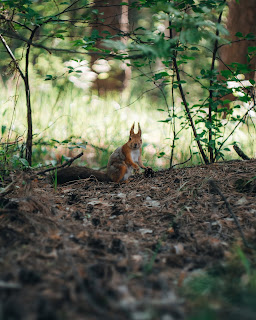Hello Everyone,
This week's animal of the week is the red squirrel. There are lots of different types of squirrel (about 200 as this includes marmots and prairie dogs). I have some grey squirrels in my garden and you might too. We often see them so hopefully you can learn about red squirrels today.
This week's animal of the week is the red squirrel. There are lots of different types of squirrel (about 200 as this includes marmots and prairie dogs). I have some grey squirrels in my garden and you might too. We often see them so hopefully you can learn about red squirrels today.
Habitat
As you might know, squirrels live mainly in woodland areas. The red squirrel
can live in all types of woodland, even if it is quite small. See the maps
below for more information on where they live.
Diet
They feed on mainly nuts, fruit, fungi and other plants. They need to chew as
their teeth grow continuously and so can grow so long that they can't eat if
they don't chew often. When food is scarce they can eat some insects and small
vertebrates.
What is thought of them
Squirrels are sometimes seen as pests, but not usually as much as many other
rodents. They can raid bird feeders (they manage to get in to mine even if my
feeders are supposedly squirrel-proof), and squatting in attics. They can make
a mess, and a lot of noise when they are in your attic! This is mainly grey
squirrels as I explain below.
Are they endangered?
They have historically been eaten in many cultures but the biggest problem in
the United Kingdom is that invasive grey squirrels are killing off the native
red squirrels. However red squirrels are classed as
Least Concern
as they may not be thriving in the UK but are elsewhere. However, the
population is declining.
So overall, they are in decline but not drastically as they are so widespread in Europe and parts of Asia.
Thank you for taking the time to read this. We hope it has been useful and interesting!
Sources:
https://www.wildlifetrusts.org/wildlife-explorer/mammals/red-squirrel
https://www.iucnredlist.org/species/20025/115155900
https://www.woodlandtrust.org.uk/trees-woods-and-wildlife/animals/mammals/red-squirrel/
Images:
Red squirrel close up: This image is owned by David Selbert on pexels.com.
Red squirrel on ground: This image is owned by Michael Telitsyn on pexels.com.
So overall, they are in decline but not drastically as they are so widespread in Europe and parts of Asia.
Thank you for taking the time to read this. We hope it has been useful and interesting!
Sources:
https://www.wildlifetrusts.org/wildlife-explorer/mammals/red-squirrel
https://www.iucnredlist.org/species/20025/115155900
https://www.woodlandtrust.org.uk/trees-woods-and-wildlife/animals/mammals/red-squirrel/
Images:
Red squirrel close up: This image is owned by David Selbert on pexels.com.
Red squirrel on ground: This image is owned by Michael Telitsyn on pexels.com.



Comments
Post a Comment